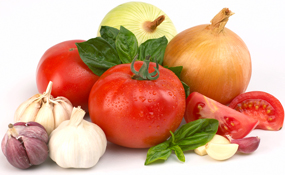Italian cuisine goes far beyond pizza, pasta and meatball sandwiches. In fact, depending on the region – Rome, Tuscany or Sicily – you may find polenta or risotto instead of pasta, lamb instead of seafood or flatbread versus thicker-crust pizza. But no matter where your Italian fare hales from, it’s guaranteed to include simple ingredients like tomatoes, garlic, olive oil, dark leafy greens and whole grains. And that makes it one of the world’s healthiest cuisines.
Indeed, experts agree that following a Mediterranean-style diet, including Italian cuisine, promotes longevity. And the benefits range from improved weight loss and better blood-glucose (sugar) control to a lower risk of chronic conditions ranging from cancer to depression.
While it’s tough to say which ingredients pack the greatest health punch (there are so many to choose from!), experts agree the following five Italian staples are nutritional superstars:
- Tomatoes: Whether incorporated into sauce or soups, sun-dried or sliced fresh for a Caprese salad, tomatoes are a mainstay of Italian cooking. Packed with vitamins C, A and K, tomatoes are also rich in heart-protective lycopene, an antioxidant with powerful cancer-fighting properties. Lycopene protects cells from oxygen damage, fights colorectal, prostate, breast, endometrial, lung, and pancreatic cancers, and reduces your risk of heart disease. Although cooked tomatoes boast less vitamin C than raw, they’re also higher in lycopene. A bonus: Lycopene is best absorbed when cooked with a little oil, making Italian sauces an ideal source.
- Anchovies: Whether mixed into a Caesar salad or used as a topping for pizza, anchovies are a fantastic source of healthy omega-3 fats in your favorite Italian meal. Researchers are just beginning to uncover the countless benefits of eicosapentaenoic acid (EPA) and docosahexaenoic acid (DHA), two omega-3 fatty acids that have been linked to everything from a reduced risk of cancer and stroke to improved mood. These tasty fish are also packed with bone-building calcium and iron – two minerals that can be tough to get in the typical American diet. A bonus: Anchovies are loaded with choline, an important nutrient involved in controlling muscles, memory and other functions.
- Garlic: Italians love their garlic! In fact, you’ll find this pungent disease-fighting ingredient laced in everything from pizza and bread to soups and sauces. You’ll even find the whole clove roasted and served solo. A number of studies show that the garlic (and other members of the allium vegetable family like onions, scallions, chives and leeks) help fight breast, colon, stomach, throat and skin cancers. It’s heart-healthy and has been shown to prevent clotting, lower blood pressure levels and improve cholesterol profiles. Plus, garlic has powerful antifungal, antibacterial and antiviral properties, making it a great choice during flu season. Already sick? Some evidence suggests garlic acts as a potent antibiotic, too!
- Olive Oil: Olives make an appearance in Italian dishes ranging from antipasto to dessert and their oils are a hallmark of Italian cuisine. Olive oil boasts heart-healthy monounsaturated fats, which have been shown to lower “bad” LDL cholesterol and boost levels of “good” HDL cholesterol. And it’s loaded with powerful polyphenols, flavonoids and vitamin E – a combination that helps reduce inflammation and protect against colon cancer and heart disease. A study published in the Archives of Internal Medicine, for example, found that among people with high blood pressure, those who were given olive oil significantly lowered their blood pressure compared to those who were given sunflower oil (a typical oil used in western diets). What’s more, the olive oil group lowered their need for blood pressure meds by a whopping 48 percent.
- Basil: Basil is a key flavor-enhancing herb in Italian cuisine, and it’s the primary ingredient in pesto, an Italian sauce featuring basil, Parmesan cheese, pine nuts, olive oil and garlic. Pesto is usually served with pasta, but these days, you’ll see pesto mayo on sandwiches and even pizza with pesto sauce. Basil is a good source of vitamin A, iron and calcium. It’s rich in antioxidants called flavonoids that protect cells from radiation and oxidative damage. And it has antibacterial and anti-inflammatory properties to boot! What does that mean for you? Basil can help ward off unwanted bacteria, as well as reduce inflammation, which is linked to everything from arthritis to stroke.
With all of these health benefits, it’s no wonder Italian cuisine is so popular here in the States. Still, its greatest coup is taste. Rich tomato sauces, flavorful herbs, colorful fruits and vegetables and healthful oils are all hallmarks of Italian cooking. Also, in stark contrast to America, eating in Italy is a lengthy process, meant to be savored. A typical Italian meal starts with antipasto and is followed by a pasta course (or polenta, risotto or soup), then a meat, seafood or vegetable dish. Next comes salad, a fruit and cheese course, and a sweet dessert. That’s a far cry from the American way of wolfing down a meal. So, what are you waiting for? Select a Healthy Dining Italian restaurant, order a glass of Chianti and toast to your health.

